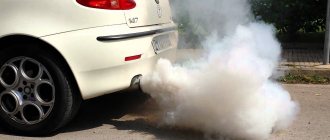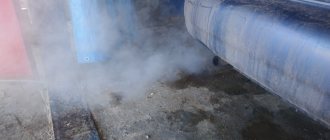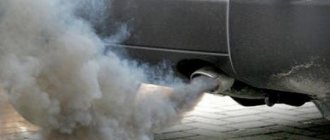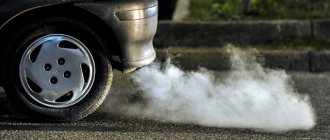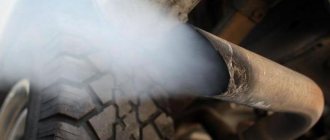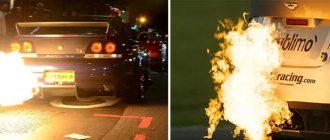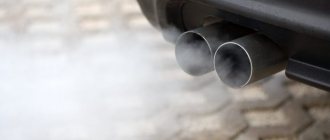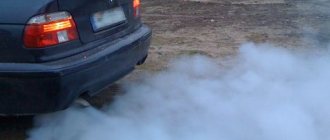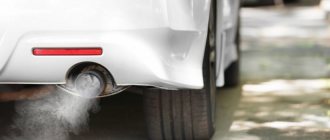What does the blue smoke coming from your car's exhaust pipe mean? Doesn't he remind you of Bluebeard from Charles Perrault's fairy tale? This villain killed his wives allegedly because of their excessive curiosity, which he considered a moral flaw. Well, what can we say, he is a maniac and a maniac in France. Moreover, some believe that curiosity is not a vice, but a source of knowledge.
Curious readers will learn from this article what leads to such a beautiful color of a car exhaust.
Why does a gasoline engine smoke?
When you see a smoking car on the road, you can confidently say that there are problems with its engine. If it is in good condition, the exhaust will be transparent, since it does not contain any coloring substances. What do gasoline engine exhaust gases consist of?
95% of their volume consists of nitrogen, oxygen, as well as gaseous products of gasoline combustion: nitrogen oxides, carbon oxides and hydrocarbon radicals. All these substances are colorless, so the human eye cannot detect them. Finally, from 3 to 5% of the exhaust is water vapor, which is a product of pyrolysis (thermal decomposition) of gasoline molecules.
It remains to be assumed that smoke from the muffler pipe appears when some foreign substances other than gasoline are burned in the engine cylinders. And indeed it is. A gasoline engine uses some auxiliary materials during operation. Liquid motor oil is used to lubricate parts, and coolant (antifreeze or antifreeze) is used to cool the cylinders.
For a number of reasons, these liquids can enter the cylinders, where they mix with fuel. The products of their combustion give color to the exhaust gases - the engine begins to smoke. Moreover, the escaping smoke can have different colors and shades. They can be divided into three groups: white, blue and black smoke. An experienced mechanic can determine the cause of the malfunction by the nature of the smoke.
The nature of smoke and the degree of wear of the power unit
Experienced specialists, based on their own observations or the client’s descriptions of the characteristics of smoke, can with a high degree of probability guess the nature of the problem. Let's look at a few common cases :
- If the blue-white exhaust appears only when the engine warms up and gradually disappears as it warms up, then there is no reason to fear serious wear of the mechanisms. This effect is explained by the ability of parts to expand; when heated, the gaps decrease and oil leakage stops.
- In the case when, after warming up the power unit, smoking not only continues, but also intensifies, it can be argued that there is significant wear of the internal combustion engine elements. The reason is the following - the expansion is not enough to reliably seal the gaps and through them hot oil easily penetrates into the cylinders.
What does blue smoke mean?
To understand why the engine emits blue smoke, just use a simple indicator. A sheet of writing paper is brought to the muffler pipe. After some time, the paper surface becomes covered with oil drops.
This indicates that oil particles give the blue or blue color to the exhaust. But, if it is present in the exhaust gases, it means that it somehow enters the combustion chamber. If the reader mentally imagines its structure, it is not difficult to identify probable sources. They may be:
- Intake manifold channels. During the suction stroke, the intake valves open, through which, theoretically, oil can enter along with air (or the fuel-air mixture in carburetor engines).
- Crankcase. Oil leaks from the crankcase space when there are any malfunctions of the piston rings.
- Valve box. Oil penetrates through worn intake or exhaust valve seals (oil seals).
Parting recommendations
If diagnostic results are unsatisfactory, experienced owners usually act by elimination. First, an attempt is made to decarbonize the oil scraper rings. If this is your first time encountering this concept, we recommend reading about what decarbonization is and why the engine needs it, as well as about the technology for decaburning piston rings using dimexide, as one of the inexpensive and effective means.
If an attempt to remove coke does not bring results, then work is planned on the cylinder head. If replacing the valve stem seals is unsuccessful, then a “overhaul” is performed.
Source
Oil from the air
During the intake stroke, the air (or the fuel-air mixture in carburetor engines) first passes through the air filter. Often the driver does not pay attention to the condition of the crankcase ventilation system, which is why the channels become clogged with oily deposits, and the increased pressure of crankcase gases pushes engine oil into the air filter housing.
For a careless driver, the filter element is often unable to retain liquid lubricant, and it enters the cylinders with air.
For turbocharged engines, the rotor is lubricated with liquid oil using a special oil pump. Due to wear, the gaps in the bearings increase, through which oil begins to flow into the cold (air) cavity of the turbine. Here it is sprayed by the impeller and mixed with the forced air, after which it enters the combustion chamber.
Another rare case, occurring only on cars with an automatic transmission equipped with a vacuum load sensor. The latter is connected to the intake manifold using a hose. Sometimes it happens that the sensor diaphragm breaks, and the vacuum in the manifold sucks oil from the box. Not only does the box lose one of the control systems and lose oil, but it is also the culprit of engine smoke.
Valve seals or rings: how to determine what caused the blue smoke
If you've done a quick study of the issue, you've probably noticed that there is a lot of conflicting information. For example, there is a lot of controversy around the same compression: some argue that with normal pressure in the cylinders there is no reason to go into the piston, others insist that this is not an indicator at all in the current situation. And regarding the relationship between the engine temperature, the position of the gas pedal and the time of appearance of bluish smoke, it is not at all clear what’s what.
Let us immediately note that there is no connection between compression and defective oil scraper rings. Firstly, the rings that scrape oil from the cylinders wear out or become stuck first, while the compression rings continue to work as expected. Secondly, even with slightly worn compression rings and damaged oil scraper rings, compression will be normal, since the oil remains on the cylinder walls.
At the same time, unspoken differences exist that make it possible to determine what exactly has failed: caps or oil scraper rings. The difference is that each group of parts produces blue smoke at different intervals.
Symptoms of problems with caps
In the old days, stiff or worn valve seals were indicated by a puff of bluish smoke that burst out of the exhaust pipe immediately after starting the engine. By the way, these observations have not lost their relevance today. Even in this situation, it would be a good idea to ask how much the work costs and what else needs to be changed when replacing the valve stem seals on the engine.
The following test will help you accurately judge the caps for replacement:
- Warm up the engine to operating temperature.
- Let the engine run for 5-7 minutes while warm.
- Sharply depress the gas pedal for 5-10 seconds and watch the exhaust gases at this moment.
If there are problems with the seals, in the first seconds of the “gas to the floor” mode, a cloud of smoke with a bright bluish tint flies out of the muffler. For extra confidence, repeat the attempt to throttle to failure 2-3 more times. Observations are such that in subsequent cycles the puff of smoke will lose saturation, and may even disappear altogether.
What explains this prioritization? If the cap is worn, oil will flow down the valve stem when the engine is running. Whether it will accumulate on the valve plate or immediately enter the cylinders is determined by the angle of the throttle valve. So, at idle, the speed of the air mass is low, the oil is not removed from the plate, but continues to accumulate
As soon as you sharply (it is important to press this way) press the gas pedal, the air or fuel-air mixture (depending on the type of fuel injection) draws the accumulated oil emulsion into the cylinders and it burns, forming a bluish smoke
There will be no ominous tint at revs, and, in fact, there shouldn’t be. The oil does not have time to accumulate, but immediately enters the cylinders and burns in small fractions, which is why it does not affect the color of the exhaust gases.
It is worth noting that with a new catalyst, the color of the exhaust may not change at all, since it qualitatively converts CH into water vapor. On a half-dead catalytic converter or installed flame arrester, the picture appears in all its glory: there is smoke.
How to determine whether oil rings are faulty
Worn rings make themselves felt when under load. In reality, it looks like this: the color of the exhaust gases changes when moving uphill with the gas pedal half-pressed. It is worth noting that looking in the rearview mirror, you are unlikely to draw the right conclusion. The puff of smoke usually dissipates quickly. However, the driver of the car behind may well record his appearance.
When the rings are worn critically, smoke comes out constantly while driving and regardless of the terrain under the wheels. In addition, an increase in smoke is observed with increasing speed.
What else could cause a bluish-colored exhaust?
A defective turbine and faulty crankcase ventilation can also cause smoke. What distinguishes these failures from current caps or oil rings is the nature of the smoke: there is a lot of smoke + it can appear and disappear at any time. For example, the engine runs smoothly at idle and suddenly starts smoking, and after 3-4 minutes it stops.
A few tips will help you figure out what's going on:
- The turbine “drives” oil into the exhaust pipe. Smoke appears only after the exhaust tract has warmed up. There may be an oil leak at the joints of the exhaust system parts.
- Crankcase ventilation does not separate the oil from the air mixture. The oil separator is clogged as a result of using low-quality engine lubricant. The intake manifold is covered in streaks of oil emulsion, and clearly behind the ventilation hole.
Fellowship of the Rings
Now let's talk about how oil gets from the crankcase directly into the working chamber. Pistons of internal combustion engines (ICEs) operate under conditions of high temperatures and significant friction forces. Oil poured into the engine crankcase is used to lubricate and cool the rubbing surfaces. It is supplied to the cylinder walls by spraying or under pressure using special piston nozzles.
During the upward stroke of the piston, an oil film is applied to the surface of the liner; during the downward stroke, the oil scraper ring removes the heated lubricant, taking heat from the cylinder walls. Compression rings are used to isolate the combustion chamber from engine oil, as well as to create a certain pressure (compression) in it.
Typically, the pistons of a gasoline engine have 3 rings (like the elf tribe): one lower - oil scraper and two upper - compression.
As a result of wear of the compression rings, hot working gases begin to break into the crankcase space, which leads to an increase in the medium pressure in it. And due to the vacuum formed above the piston head, oil from the crankcase is sucked into the cylinder cavity. Thus, oil enters the cylinders due to wear of parts of the cylinder-piston group (CPG). What can contribute to the development of this process:
- Wear of oil scraper and compression rings. Leads to an increase in gaps, as a result of which the barrier between the gas and oil environments disappears.
- Development of piston grooves. As their width increases, the performance of the labyrinth seal deteriorates, and a suction effect also occurs, due to which the oil is pumped from the crankcase into the cylinder, as if by a pump.
- Destruction of intergroove bridges. This defect is often observed on pistons due to a phenomenon called thermal fatigue of the material.
- Coking of rings. When oil burns, carbon deposits form, which deprives the rings of mobility, and they lose the ability to elastically press against the cylinder walls.
- Changing the shape of the cylinder walls and piston geometry.
- Seizures that form on the cylinder walls due to improper operation of the lubrication system (oil starvation).
- Poor quality lubricants or the use of oil with inappropriate performance characteristics, for example, the wrong viscosity.
- Installation of rings without using a special puller. In this case, the part is deformed, which leads to accelerated wear of the cylinder mirror.
When the valve seal wears out
Finally, the last route for oil to enter the exhaust tract of a gasoline internal combustion engine is through valve seals: valve stem seals or valve seals. Rubber rings are used to seal the guide bushings.
Rubber is generally sensitive to temperature changes. And the details in question are thrown, like Ivan the Fool, “from a cauldron of cold water and into another cauldron of boiled water.” In winter, before starting the engine, they can be completely frozen, and after a while they heat up over one hundred degrees. For example, exhaust valve bushings heat up to 120 - 220°C, and their stems - up to 220 - 400°C.
It is not surprising that over time, oil seals lose their elasticity and “dull,” as drivers say. As a result, the quality of the seal deteriorates, and oil begins to be sucked in or driven through the guide bushings: into the suction chamber, or directly into the exhaust manifold, where it burns.
Symptoms of oil burn
Signs of oil entering the combustible fuel-air mixture:
- The engine smokes blue or bluish-gray, and oil consumption increases. The smoke thickens especially in dynamic driving modes.
- At the beginning of wear, smoking occurs only when the engine warms up (“cold”), until the thermal clearances return to normal. With further heating, the smokiness normalizes. Therefore, checking the compression in the cylinders does not always reveal a malfunction.
- As wear progresses, the picture changes. Despite the fact that as the engine heats up, the thermal gaps decrease, they are no longer able to prevent the penetration of oil through the gaps. With increasing heating, the latter becomes more and more diluted, as a result of which the consumption of lubricant increases.
- Oil entering the cylinders splashes the spark plugs, causing them to become covered with soot. And this causes a weakening of the spark and misfires. The engine, as they say, “does not pull” or begins to “trouble”.
- A diaphragm rupture on the automatic transmission vacuum sensor is diagnosed by turning out the cylinder spark plug located next to the connection point of the vacuum hose. This candle will be splashed with oil while the others remain dry.
Troubleshooting should begin with a compression check. If, as mentioned above, the results are not reliable, check the condition of the valve stem seals, since this work is less labor-intensive compared to disassembling the CPG. And only lastly do they begin to thoroughly disassemble the engine.
Even if you are not able to eliminate the causes of blue smoke in a gasoline engine on your own, it is quite possible to at least get an idea of possible malfunctions. And this will allow you to avoid unnecessary expenses when drawing up a schedule of restoration work, which must be drawn up by repair service workers.
Unburned fuel
This assumption will be confirmed by the presence of a strong pungent odor from the exhaust system. This means that unburned fuel comes out with smoke in the form of vapor.
Fuel may not burn for various reasons. It may be that the fuel is delivered too late or one of the cylinders is not doing its job and is unable to burn the fuel.
As a rule, every consequence has its own cause. The consequence of this is unburned fuel and, as a result, blue smoke from the engine. So what reasons and problems in diesel units can cause this?
Injection pump faulty
If the cause of the blue smoke is untimely injection, pay attention to the wear of the injection pump (fuel injection pump). It is easy to guess that the fuel will not burn if it is delivered late.
So, we have identified one of the possible culprits. But why is this so? The design and layout of the injection pump is not simple. To explain in simple words, the operation of this unit is based on the movement of special fuel supply mechanisms, which constantly rub and touch each other.
The lubricant for the parts is the fuel itself. Quite a difficult decision, since diesel fuel has an oily structure. However, with the onset of winter there is a transition to winter fuel.
It is called winter because the viscosity decreases, namely due to the absence of these lubricating fractions or their quantity is insufficient to lubricate the “equipment” in the pump. This is the cause of pump wear. Wear of this part of the unit, in turn, along with the wave profile of the sprinkler, causes a delay in fuel injection.
The mechanism is this: the fuel does not have time to warm up due to the injection delay and the cylinder begins to work poorly intermittently. As a result, fuel that does not burn comes out as blue smoke.
If the engine warms up after driving a few kilometers, the bluish trail behind the car will disappear or become so small that it can no longer be traced. However, the pump failure will not be corrected. When the engine is warmed up, even fuel supplied late has time to burn almost completely due to the high background temperature.
Poor engine compression
There are times when strong blue smoke appears when starting the engine. And then, when heated correctly, the smoke disappears. This picture is quite common in the yards of our country, when columns of smoke appear and the driver runs, clutching his head, and cannot understand what is happening.
The reason is low engine compression. Due to this defect, the compression temperature does not reach the correct value, so the fuel does not burn completely. Even if the engine has one cylinder with low compression, operation of such an engine is possible. But he will continue to smoke until
Blue smoke can be caused by mistimed injection or low compression.
The cause of blue smoke may be untimely injection or low compression. By the way, most modern diesel engines are equipped with a device on the fuel pump that performs early injection while the engine is still cold.
